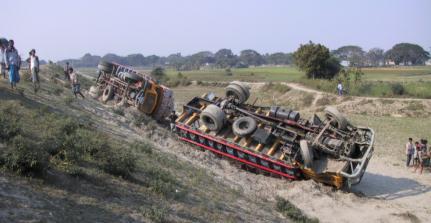Knowledge fuels change - Support energypedia!
For over 10 years, energypedia has been connecting energy experts around the world — helping them share knowledge, learn from each other, and accelerate the global energy transition.
Today, we ask for your support to keep this platform free and accessible to all.
Even a small contribution makes a big difference! If just 10–20% of our 60,000+ monthly visitors donated the equivalent of a cup of coffee — €5 — Energypedia would be fully funded for a whole year.
Is the knowledge you’ve gained through Energypedia this year worth €5 or more?
Your donation keeps the platform running, helps us create new knowledge products, and contributes directly to achieving SDG 7.
Thank you for your support, your donation, big or small, truly matters!
The Environment and Safety: Adverse Effects of Transport Infrastructure
Overview
This articles gives an overview about negative effects of transport infrastructure focusing on environmental aspects, the spread of HIV and accidents.
Effects on the Environment
The construction of transport routes in rural areas opens up access to previously remote ecosystems and thereby facilitates the clearance of forests, much of which is carried out illegally. Studies show that around two-thirds of all forest clearance can be attributed to the construction of transport infrastructure. The accompanying problems include noise nuisance, air pollution and higher numbers of accidents.
In addition to facilitating illegal logging, the increased accessibility provided by transport routes and the accompanying reductions in transport times and costs also put indigenous peoples at risk, provide easier access for poachers and promote land speculation, the construction of illegal settlements and uncontrolled exploitation of minerals and natural resources (Geist, Lambin 2001).Illegal mining activities destroy farmland and create disorder in rural areas, disrupting both the physical and the social fabric of communities. In the southwest of Burkina Faso, for example, laboriously rehabilitated farmland is being ruined again by unregulated gold mining. In this context it is also worth pointing out that the construction of transport routes can also change land-use conditions to the disadvantage of the resident rural population. For example, road building can provide momentum for negative impacts such as land grabbing or forced displacement of the resident population, perhaps to land that has not yet been made cultivatable. [1] [2]
Spread of HIV
Transport projects that connect corridors or countries also help to accelerate the spread of disease. Particularly noticeable is the spread of HIV as the virus is exchanged between local people and lorry drivers or construction workers, who often spend a long time living away from their families. For some poor rural dwellers, prostitution with the relatively affluent lorry drivers is an important source of income that enables them to feed their families. According to a study conducted by the World Bank in South-East Asia, up to 80 per cent of long-distance lorry drivers regularly use the services of prostitutes (World Bank).[2]
Road Safety
Facts:
Road crashes now kill 1.3m people a year, more than malaria or tuberculosis. On present trends, by 2030 they will take a greater toll than the two together, and greater even than HIV/AIDS (see article). The vast majority of victims die in poor and middle-income countries—1.2m in 2011, compared with 99,000 in rich ones. For every 100,000 cars in the rich world, fewer than 15 people die each year. In Ethiopia the figure is 250 times higher.
Young and socially disadvantaged people have a higher than average risk of being involved in road accidents ; where someone lives is also a key factor in their accident risk. Infact lately the term road accidents is rather replaced with road crahes as factors contributing are predictable and hence aviodable.Studies of the Bangalore area of India show the risk of being killed in a road accident is three to four times higher in rural areas than it is in urban districts. One reason for this is the tendency of drivers to over-estimate their skill and to drive excessively fast outside built-up areas. When an accident occurs in a rural area, medical assistance is often a long way away and is rarely up to the standard available in towns and cities. Accessing medical care or paying for a funeral as a consequence of a traffic accident often plunges entire families in developing countries into significant financial dependency (WHO 2009).[2]
Conclusions
The examples of negative external effects have demonstrated that these effects must be considered right from the start when transport projects are being planned. The relevant impact assessments are now standard in financial cooperation projects. Support measures should be offered, and the implementation process should include everyone affected or involved – the rural population, decision-makers at national and district level and local people. Specific roles, responsibilities and tasks can be assigned and stakeholders can be supported through training and advice. For example, young people can act as school crossing patrols, workers can be responsible for the distribution of information materials at payment points and lorry drivers can help pass on these materials. Local and national government offices have a part to play in planning and implementing measures that affect land use, compliance with legislation, transport planning, capacity development of village and community structures and the use of natural resources.[2]
Further Information
References
- ↑ http://www.unescap.org/ttdw/MCT2006/Documents/English/MCT_SGO_7E.pdf
- ↑ 2.0 2.1 2.2 2.3 Schmid, D.; Bartholdi, M.; Moosmann, K; Czeh, A.; Engelskirchen, M.(2013): Improving the Accessibility of Rural Areas – The Contribution of Transport to Rural Development . Eschborn, Germany: GIZ GmbH (Deutsche Gesellschaft für Internationale Zusammenarbeit) and KfW Bankengruppe.




















